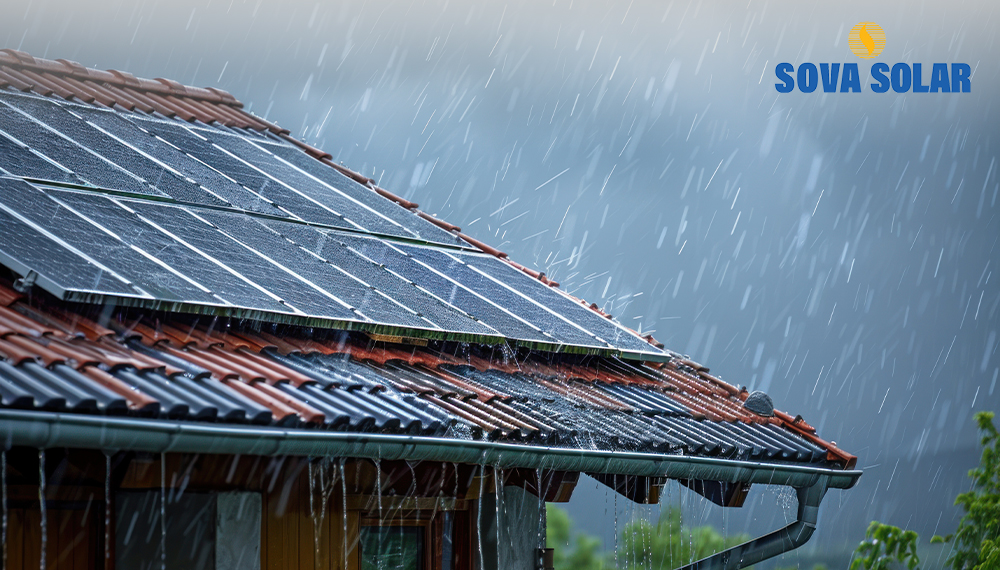
- sovasolar_admin
- Jan 16, 2025
- solar
- 0 Comments
As the adoption of solar energy continues to rise in India, one question often looms large in the minds of potential adopters: “Can solar panels withstand the Indian monsoon?” With heavy rainfall, high humidity, and occasional hailstorms, the monsoon season presents unique challenges for any outdoor equipment. However, modern solar panels are engineered to not just endure but thrive in these conditions. Let’s bust some myths and explore how advanced solar technology ensures durability and performance during the monsoons.
The Myth: Monsoons Are Solar’s Worst Enemy
It’s easy to assume that rain and solar panels don’t mix well. Common concerns include:
- Reduced efficiency due to cloudy weather
- Potential water damage to panels or wiring
- Structural vulnerabilities during high winds or hailstorms
While these are valid concerns, they stem largely from misconceptions. The reality is that solar panels are designed with durability in mind and come equipped with features that make them resilient to harsh weather conditions.
How Modern Solar Panels Are Built for Resilience
- Waterproof Design:
- Solar panels are constructed with tempered glass and sealed with high-quality, weatherproof materials. This ensures they are impervious to water ingress, even during torrential downpours.
- Corrosion Resistance:
- India’s humid monsoon conditions could cause rust in poorly made products. However, modern panels use corrosion-resistant aluminum frames and anti-rust coatings, making them suitable for high-humidity regions.
- High Wind Tolerance:
- Solar panels and their mounting systems are tested to withstand wind speeds of up to 150 km/h or more. This is especially important in coastal and cyclone-prone areas.
- Hailstone Impact Testing:
- Quality panels are subjected to rigorous tests, including the ability to endure hailstones traveling at high speeds. This ensures their structural integrity remains intact even during extreme weather events.
- Self-Cleaning Surface:
- The tempered glass used in solar panels often has a hydrophobic coating. This not only repels water but also reduces dirt accumulation, ensuring panels remain cleaner during the rainy season.
Performance During Monsoons: What to Expect
While it’s true that solar panels generate less electricity on cloudy days, this doesn’t render them ineffective. Here’s why:
- Diffuse Light Utilization: Solar panels can capture and convert diffuse sunlight (light scattered by clouds) into energy. Even during overcast days, they continue to generate electricity, albeit at a slightly reduced efficiency.
- Temperature Advantage: Rain helps cool down solar panels, which can improve their efficiency. Solar panels perform best when operating at lower temperatures, so the cooling effect of rain can be a hidden advantage.
- Energy Storage Solutions: Combining solar panels with battery storage systems ensures uninterrupted power supply. Excess energy generated during sunny days can be stored and used during low-generation periods in the monsoon.
Real-Life Examples: Solar Success Stories During Monsoons
- Agricultural Solar Pumps:
- In regions like Maharashtra and Uttar Pradesh, solar-powered irrigation systems have proven to be reliable even during the rainy season. Farmers report minimal downtime thanks to robust panel construction.
- Industrial Rooftops:
- Factories and warehouses equipped with solar installations, such as those powered by Sova Solar panels, have maintained consistent energy output through multiple monsoon seasons.
- Residential Installations:
- In cities like Mumbai and Kolkata, known for heavy rainfall, residential solar systems continue to perform effectively, reducing grid dependency even in peak monsoon months.
Why Choose Sova Solar Panels for Monsoon Durability?
When it comes to surviving the Indian monsoon, not all solar panels are created equal. Sova Solar, recognized as the best solar panel manufacturer in India, offers products specifically designed to meet the unique challenges of the Indian climate.
- High-Quality Materials:
- Sova Solar panels are made with premium-grade tempered glass and corrosion-resistant frames, ensuring longevity and reliability.
- Stringent Testing Standards:
- Each panel undergoes rigorous testing for water resistance, wind tolerance, and hail impact, guaranteeing performance in extreme weather conditions.
- Proven Track Record:
- With successful installations across monsoon-prone regions, Sova Solar panels have demonstrated their resilience time and again.
- Comprehensive Warranty:
- Sova Solar backs its products with robust warranties, giving businesses and homeowners peace of mind during the rainy season and beyond.
Best Practices for Solar Maintenance During Monsoons
To ensure optimal performance during the rainy season, follow these maintenance tips:
- Regular Cleaning: Clear off debris like leaves and dirt that may accumulate on panels to maximize energy absorption.
- Inspection of Wiring: Check for loose or exposed wires and ensure they are securely insulated to prevent water damage.
- Drainage Check: Ensure the mounting structure has proper drainage to prevent water pooling around the panels.
- Professional Maintenance: Schedule a professional inspection to identify and address potential issues before the monsoon begins.
A Bright Future, Rain or Shine
Solar panels are not just a fair-weather friend; they are built to withstand and perform even during the challenging conditions of the Indian monsoon. With the right choice of panels, such as those from Sova Solar, businesses and homeowners can confidently invest in solar energy, knowing they are protected against weather-related uncertainties.
As India marches toward a renewable energy future, the monsoon season no longer needs to be a barrier to solar adoption. Instead, it’s just another season where the reliability of modern solar technology shines through.
Ready to make the switch to solar? Choose Sova Solar—the best solar panel manufacturer in India—and power your future, rain or shine.






